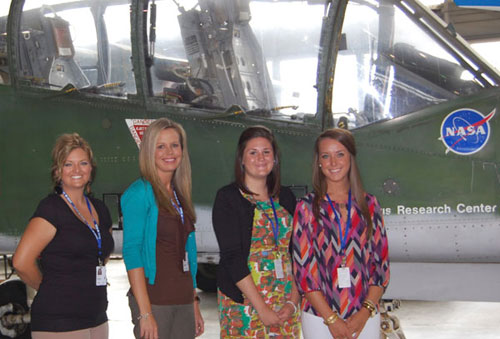Students Extend STEM Learning Through NASA Program

Melissa Brooks, from left, Lindsey Swagerty, Grace Gandy and Sarah Bart attended the 2013 NASA Pre-Service Teacher Institute this summer.
Four students from the College of Education and Health Professions were chosen this year to attend the 2013 NASA Pre-Service Teacher Institute summer program, which offers extended education training in a field that is currently lacking qualified teachers. In an ever-expanding growth of occupations that require skills in mathematics and science, the lack of qualified STEM (science, technology, engineering and mathematics) educators prompted NASA to open the doors to a program that would provide more intensive and in-depth training for pre-service teachers.
The two week program, hosted in Hampton, Va., offered more than 20 undergraduate through doctoral studies students from universities and colleges across the nation a chance to learn new methods in teaching STEM. Students not only attended workshops and lectures, but they also had the opportunity to interact with NASA scientists and engineers, take part in hands-on learning and teach and observe a class during the session.
From the University of Arkansas, doctoral candidate Lindsey Swagerty and undergraduate students Melissa Brooks, Sarah Bart and Grace Gandy attended the residential program that ran from July 22 through Aug. 2. Working with other students from across the United States along with instructors and NASA professionals, the program was nothing short of an experience of a lifetime.
"We had a really diverse group there, so that helped lead conversations and make us think outside of the box," said Swagerty, doctoral student in curriculum and instruction. "It was neat to bring in people from different areas of the country and get their views on STEM education."
Attendees spent two weeks at the residential program, which was designed in a classroom setting – students would work through activities that focused on elementary STEM specifically, in areas such as space science, life science and physics.
"The focus was how to integrate these things into the classroom," Swagerty said. "Some days we did mostly classroom work, but we had a couple of days where we got to go on field trips. Everyone who was there was interested in STEM in some form, so they took us through defining STEM and teaching us how to incorporate it into the elementary classrooms."
Students attending the program had the opportunity not only to visit the NASA center facilities but also to see the Lunar Habitat building, the Gantry Space Testing Center and the Structure and Materials lab. They also had the opportunity to visit an integrated STEM elementary school, which allowed participants an opportunity to observe STEM teaching up close.
"Seeing students design and problem solve without being told how to do that and watching them reintegrate that information at the end and show us what they learned and how they learned that was really neat," Swagerty said.
Brooks, a pre-service teacher candidate in childhood education, explained the program as a great learning opportunity.
"A lot of the activities you could actually tie into the real world," she said. "Most of the activities they applied to what they are doing today or what NASA is doing."
The classroom setting offered students insight into applying concepts from the program into school curriculum, in addition to the experience of teaching STEM and meeting with instructors from an integrated STEM elementary program.
While Swagerty, Brooks, Bart and Gandy are only four of the projected 100,000 hopeful STEM educators to enter into a teaching career in the next decade, the program provided experience and insight in how to better teach STEM in schools, prompting a higher-qualified workforce for educators who are already in high demand.
The NASA Pre-Service program will return in the summer 2014, offering more positions to students from across the nation to participate in similar programs in growing STEM education. For more information, visit Pre-Service Teacher Institutes on the NASA website.
By Emily Rhodes
Topics
Contacts
Heidi Wells, director of communications
College of Education and Health Professions
479-575-3138,
heidisw@uark.edu
Headlines
PetSmart CEO J.K. Symancyk to Speak at Walton College Commencement
J.K. Symancyk is an alumnus of the Sam M. Walton College of Business and serves on the Dean’s Executive Advisory Board.
Faulkner Center, Arkansas PBS Partner to Screen Documentary 'Gospel'
The Faulkner Performing Arts Center will host a screening of Gospel, a documentary exploring the origin of Black spirituality through sermon and song, in partnership with Arkansas PBS at 7:30 p.m. Thursday, May 2.
UAPD Officers Mills and Edwards Honored With New Roles
Veterans of the U of A Police Department, Matt Mills has been promoted to assistant chief, and Crandall Edwards has been promoted to administrative captain.
Community Design Center's Greenway Urbanism Project Wins LIV Hospitality Design Award
"Greenway Urbanism" is one of six urban strategies proposed under the Framework Plan for Cherokee Village, a project that received funding through an Our Town grant from the National Endowment for the Arts.
Spring Bike Drive Refurbishes Old Bikes for New Students
All donated bikes will be given to Pedal It Forward, a local nonprofit that will refurbish your bike and return it to the U of A campus to be gifted to a student in need. Hundreds of students have already benefited.




